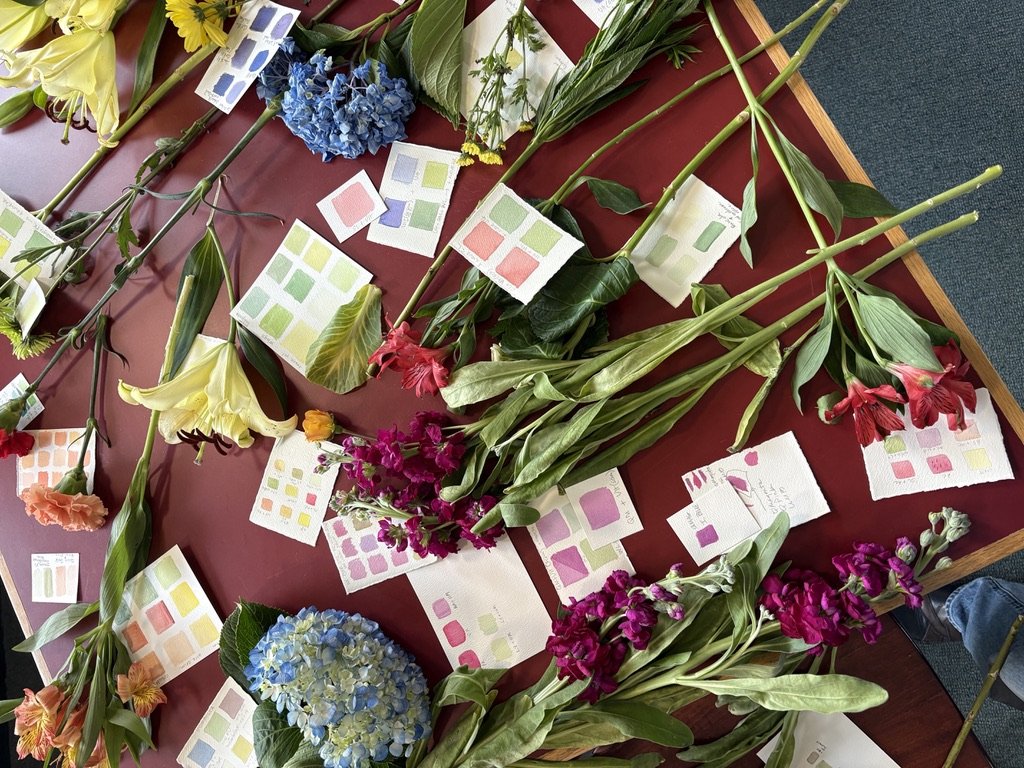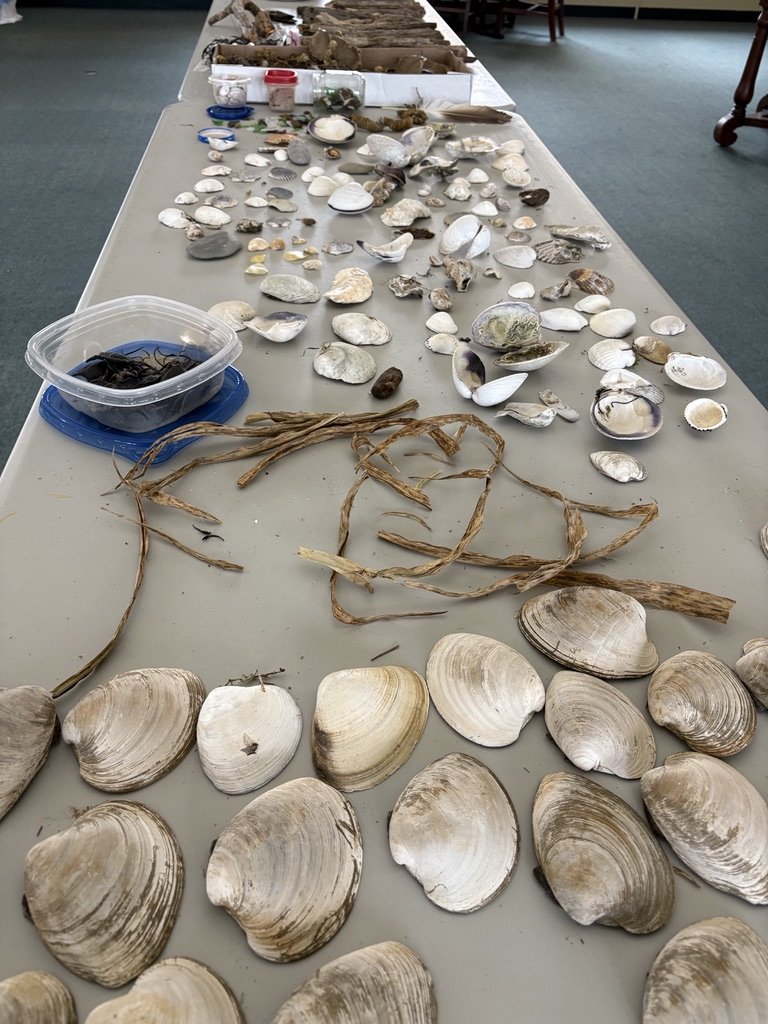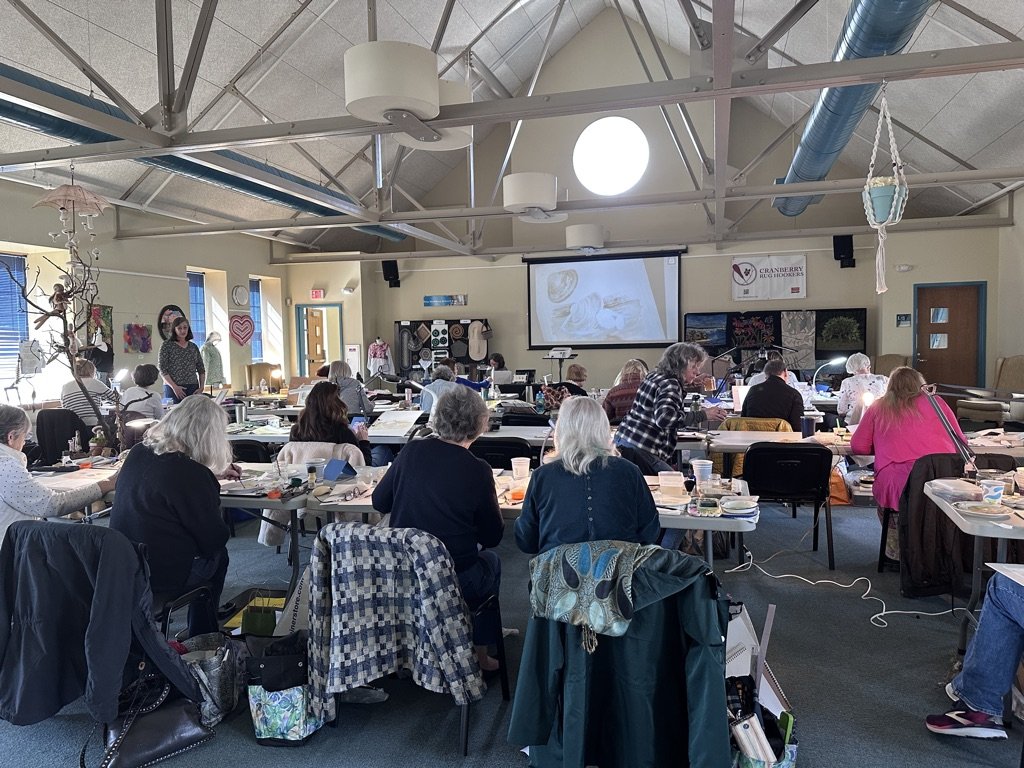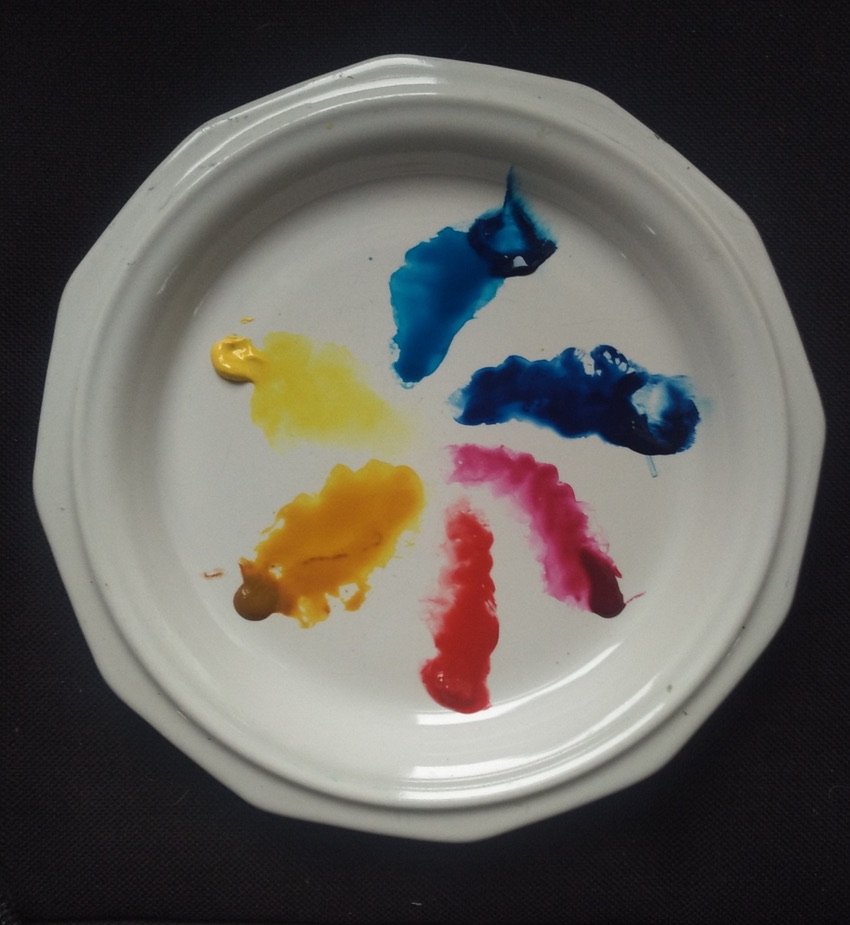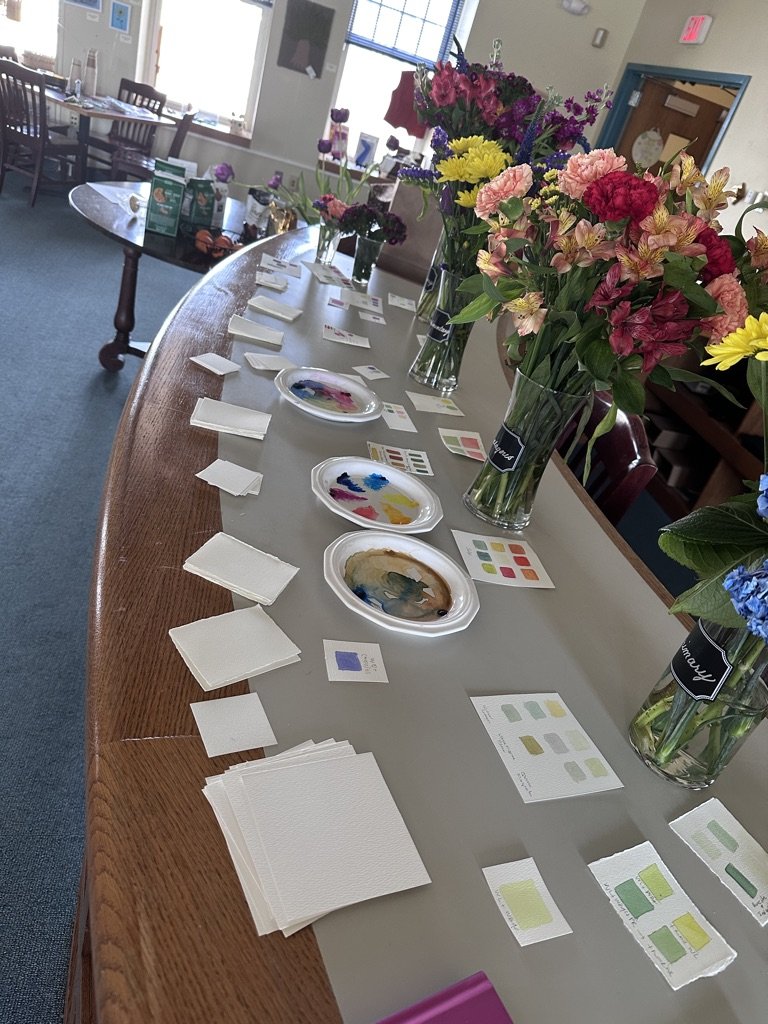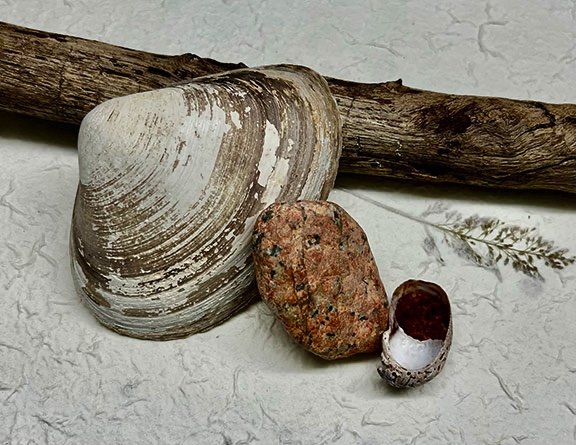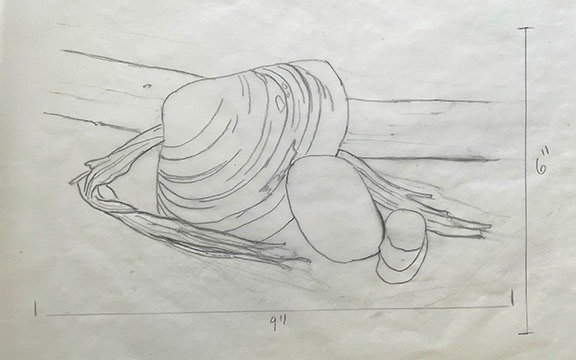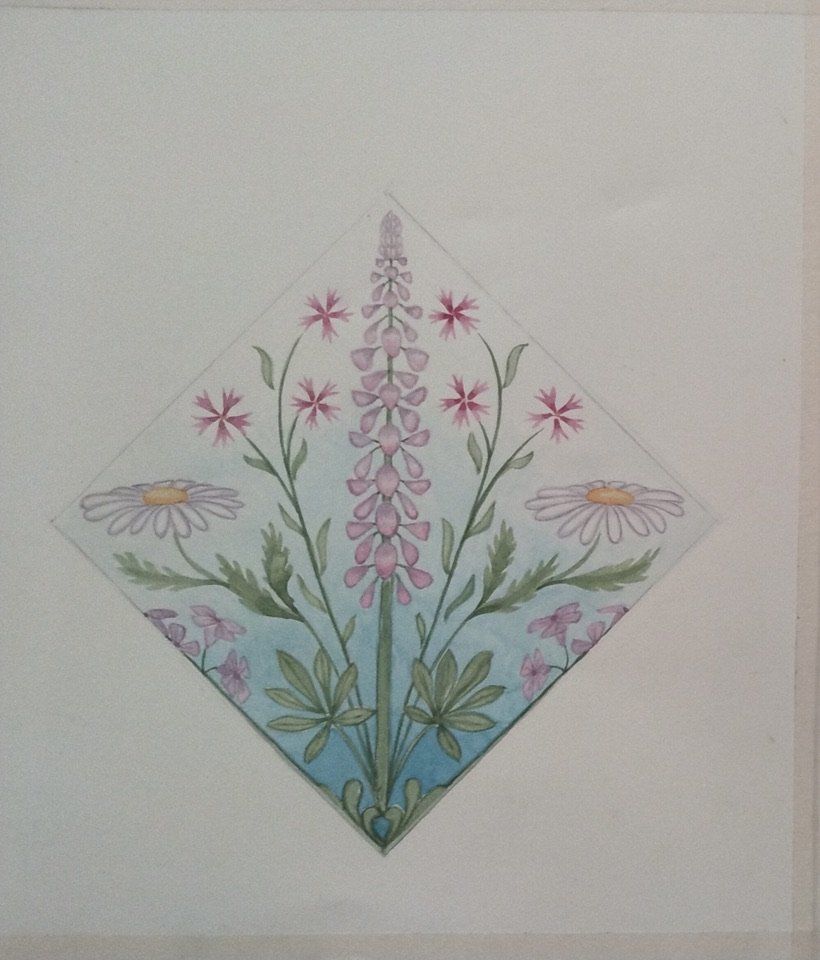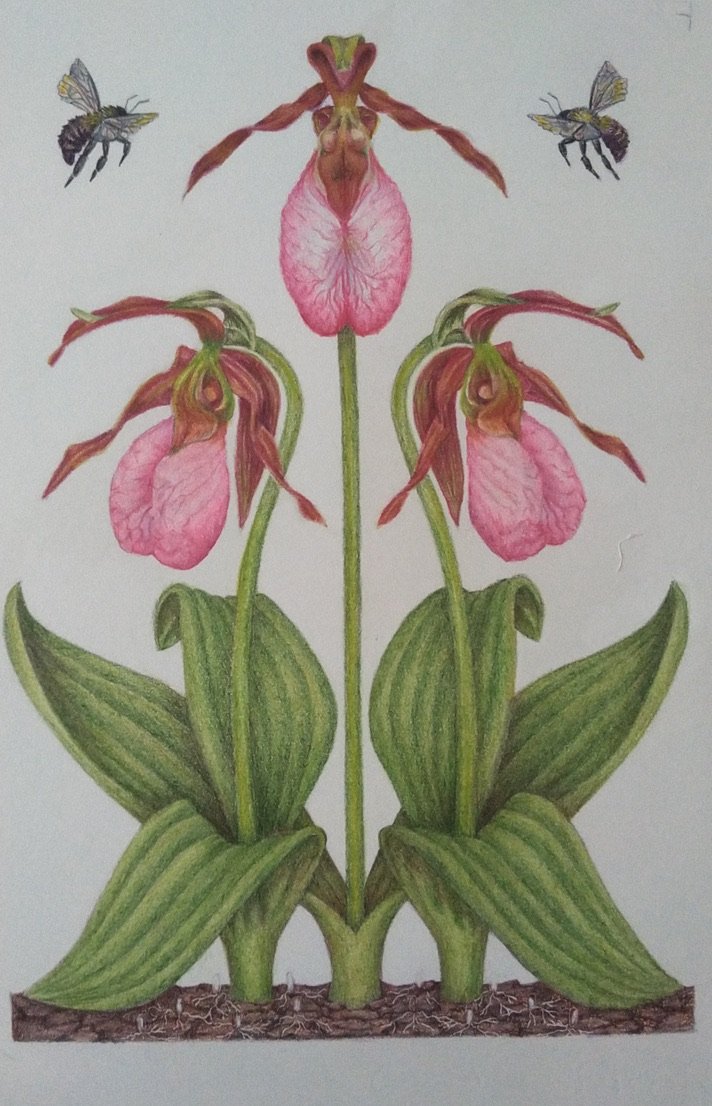by Joan Strauss
On March 21-23 twenty-five NESBA members gathered for three days of learning, creativity and connection at the 2nd Annual Retreat held at The 204 Cultural Arts Municipal Building in Harwich MA. As soon as you step through the door of The 204, you sense creativity. This former middle school is a vibrant community arts center with artist studios and space for performance, exhibits and workshops. Upon arrival, we were greeted with beautiful calligraphy place cards and name tags courtesy of artist and calligrapher Jan Boyd. We also found tables displaying our subjects for the weekend: shells, sea grass, driftwood, egg casings, and flowers. Lots of flowers.
Ellen Duarte kicked things off on Friday afternoon by asking us to arrange the flowers on the table according to the color wheel. What a fun exercise and ice breaker! Once that was accomplished, Ellen had us choose a flower and swatch of watercolor paper for color-matching exercises. She suggested that we write down our recipe on the swatch and return it with flower to the table for comparison later. We were free to use our usual color palette or experiment with a more limited range of six pigments to see how many colors could be mixed. Ellen likes to have two choices of each primary color, a warm and cool version of each. Her favorites are magenta, quinacridone red, Winsor lemon, transparent yellow, Winsor blue green shade and Winsor blue red shade. Ellen notes that Daniel Smith is offering a limited palette set for a reasonable price.
The book Color In and Out of the Garden by Lorene Edwards Forkner is full of beautiful examples of capturing the nuances of the colors of your subject in nine squares. This seems like a great way to organize color mixes for a piece that otherwise might get documented randomly (or not at all!).
To cap off the afternoon, we worked in groups to arrange the flowers based on color groups: primary, secondary, tertiary and so on. It was another great exercise to interact with other participants and to shift further into the creative mode.
On Saturday morning, Sarah Roche welcomed us saying that with 235 members, NESBA is the largest chapter in ASBA but with six board members, we probably have the smallest board. The board meets four times a year via zoom, so no travel is required. We also have three dedicated volunteers who provide zoom support for Beyond the Brush and maintain the website. She encouraged everyone to consider ways to participate.
Sarah then acknowledged Diane Piktialis and her tremendous contribution to NESBA. Diane was on the board from 2016 to 2024 first as Recording Secretary and then as President. Sarah noted that Diane’s calm demeanor was especially important during the pandemic years when NESBA pivoted to on-line programming. In appreciation of her years on the board and many contributions, Sarah presented Diane with a beautiful raspberry broach by Michael Michaud on behalf of NESBA.
The workshop Saturday was ‘Watercolor Beach Composite‘ with Betsy Rogers-Knox. Betsy provided a photo and line drawing of a small beach scene, or we could create our own using provided materials. Our goals were to learn some fun watercolor techniques to create interesting texture for driftwood, sand, rock, shells, etc. and to complete a small painting. Betsy provided step-by-step instruction and plenty of individual attention.
To move quickly with our painting, we masked the edges of the objects in the foreground with masking fluid and painted the background first. Betsy encouraged us to experiment with the masking fluid by splattering with a toothbrush or make lines with a brush or nib. Even if we were unfamiliar with masking fluid (or had a love-hate relationship with it), we all became a little more proficient under Betsy’s guidance.
Photo credit: Betsy Rogers-Knox
Painting by Sarah Roche
Moving to the foreground, we removed the masking fluid from the edges and then reapplied it where needed. It was particularly useful in establishing patterning on the small shell. Salt was used to lend texture to the rock. Since salt can be tricky, we discussed various factors affecting its performance, such as the amount of pigment used, or temperature and humidity. Betsy recommends experimenting and using salt early in the piece in case things do not go as expected.
Masking demo by Betsy Rogers Knox
We arrived Sunday morning to the unfortunate news that our instructor, Kathie Miranda, was ill. Luckily for us, Ellen Duarte lives on the Cape and was able to collect materials to lead us through a session on techniques and patterns. Ellen introduced the work of Harriet De Winton who espouses a ‘botanical adjacent’ form of painting based on simple lines and brush maneuvers. The technique can be useful in field studies to describe plant habit and color. We worked on simplified leaves, stems, and petals as well as botanical borders, all of which are well suited to greeting cards, invitations or even picture frames.
From Painting Watercolor Botanicals by Harriet De Winton
Border by Ellen Duarte
Finally, we explored ways of creating layered and repeating patterns. Ellen showed us her fabulous work on mirror images and pattern repeats, which she could envision developing into fabric designs. Keep your eyes open for ‘Fabrics by Ellen’ in the future!
One block of pattern by Ellen Duarte
Four blocks by Ellen Duarte
Mirror image by Ellen Duarte
Last but not least, THANK YOU to everyone who helped make the retreat a truly fabulous event:
Lynn Shepherd took the lead in the overall organization.
Jan Boyd created beautiful calligraphy place cards and name tags.
Ellen Duarte stepped right up to teach when Kathie was unable to come.
Lianne Gillespie took care of the technology.
Marie Brezinski helped with getting food.
Catherine Bryant, Janice McGonagle, and Carole Magner helped with cleanup.
We look forward to seeing you the 3rd Annual NESBA Retreat March 21-23, 2026. Kathy Miranda has promised to give her Dura-lar workshop. If you have any suggestions for instructors, please let us know.
